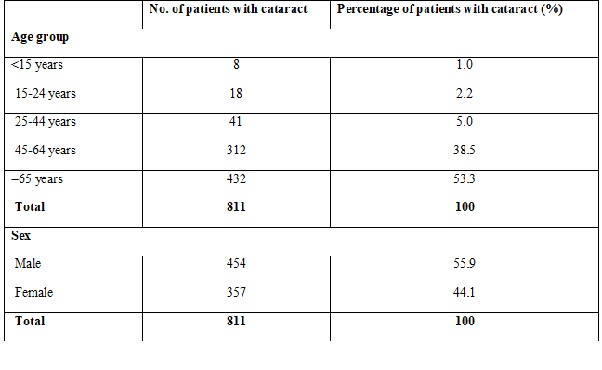Clinico-epidemiological and Socio-economic Profile of Cataract Patients from Rural Areas of Eastern Rajasthan
Abstract
Introduction: Blindness due to cataract is a global health problem. In India also it is the major cause of blindness in 62.4%. The prevalence of cataract is more in rural population owing to lack of infrastructure and manpower as well as illiteracy and poverty. There is a paucity of data on the subject from rural Rajasthan especially the eastern region. In order to optimize limited health care facilities for the target population, it is necessary to know the clinico-epidemiological and socio-economic factors associated cataract; thus, the study was conceptualized.
Materials and methods: This cross-sectional study was conducted in the National Institute of Medical Sciences, a tertiary care center situated in the rural area of Jaipur from January 2018 to December 2019. Patients having cataract and giving consent to participate in the study were included.
Results: Eight hundred and eleven cataract patients were included in the study. The majority (53.3%) of cataract patients were aged and males (55.9%). Most patients were illiterate (68.5%) and belonged to low socio-economic status (88.7%). Diabetes and hypertension were common. In our setting, senility was the most frequent cause (91.1%) followed by trauma (5.3%); Congenital cataract was least common (1.7%). Sixty-four percent of total cataract patients had bilateral affection. Majority of patients (45%) had immature cataract, 39.9% had mature and 15% had hyper-mature cataract.
Conclusion: Socioeconomic and clinico-epidemiological profile of patients living in the rural population of eastern Rajasthan share similarities with people living in other rural areas of our country.
Downloads
References
2. Mohan M. National Survey on Blindness-India. NPCB-WHO Report. New Delhi: Ministry of Health and Family Welfare, Government of India; 1989.
3. Murthy GV, Gupta SK, Bachani D, Jose R, John N. Current estimates of blindness in India. Br J Ophthalmol. 2005 Mar; 89(3):257-60. doi:10.1136/bjo.2004.056937.[pubmed]
4. Vijaya L, George R, Asokan R, Velumuri L, Ramesh SV. Prevalence and causes of low vision and blindness in an urban population: The Chennai Glaucoma Study. Indian J Ophthalmol. 2014 April; 62(4):477-81. doi: 10.4103/0301-4738.111186.[pubmed]
5. India National Census. Census of India 2011 [Internet]. New Delhi: Indian National Census; 2011 [cited 2019, June 23] Available from: www.censusindia.gov.in/2011-Common/CensusData2011.html.
6. Sharma, R. Revised Kuppuswamy’s socioeconomic status scale: explained and updated Indian Paediatr. 2017 Oct 15; 54(10): 867-70.[pubmed]
7. Avachat SS, Phalke V, Kambale S. Epidemiological correlates of cataract cases in tertiary health care center in rural area of Maharashtra. J Fam Med Primary Care. 2014 Jan-Mar;3(1):45-7.doi: 10.4103/2249-4863.130273.
8. Singh S, Pardhan S, Kulothungan V, Swaminathan G, Ravichandran JS, Ganesan S, et al. The prevalence and risk factors for cataract in rural and urban India. Indian J Ophthalmol. 2019 April;67(4):477-83. doi: 10.4103/ijo.IJO_1127_17.[pubmed]
9. Nirmalan PK, Robin AL, Katz J, Tielsch JM, Thulasiraj RD, Krishnadas R, et al. Risk factors for age related cataract in a rural population of southern India: The Aravind comprehensive eye study. Br J Ophthalmol. 2004 Aug; 88(8):989‑94. doi:10.1136/bjo.2003.038380.[pubmed]
10. Vashist P, Talwar B, Gogoi M,Maraini G, Camparini G, Ravindran RD, et al. Prevalence of cataract in an older population in India: the India study of age-related eye disease.Ophthalmology. 2011 Feb;118(2-19):272–8.e2. doi: 10.1.1016/j.ophtha.2010.05.20.[pubmed]
11. Mahajan B, Gupta M, Ray R, Saha I. Textbook of Preventive and Social Medicine, 4th edition. New Delhi: Jaypee Medical Publishers; 2012.
12. Vijaya L, George R, Rashima A, Raju, P, Arvind H, Baskaran M, et al. Outcomes of cataract surgery in a rural and urban south Indian population. Indian J Ophthalmol. 2010;58(3):223–8. doi:10.4103/0301-4738.62648.
13. Shori C, Shori R, Laxmiprasad G, Alli A. A study of clinical and ophthalmologic profile of patients undergoing cataract surgery. Int J Res Med Sci. 2017 May;5(5) :2229-32. doi:10.18203/2320-6012.ijrms20171874.
14. Manhas A, Manhas RS, Manhas GS, Gupta D. Clinical-ophthalmological profile of patients undergoing cataract surgery following their identification in screening eye camps. Int J Med Sci Public Health. 2019;8(1):38-41. Doi 10.5455/ijmsph.2019.1028707102018.

Copyright (c) 2019 Author (s). Published by Siddharth Health Research and Social Welfare Society

This work is licensed under a Creative Commons Attribution 4.0 International License.


 OAI - Open Archives Initiative
OAI - Open Archives Initiative



















 Therapoid
Therapoid

